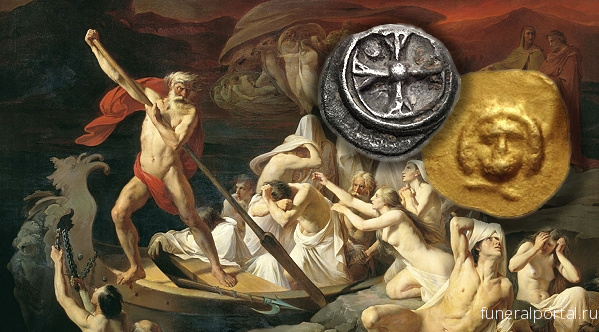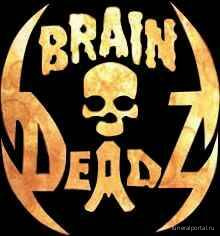By Mike Markowitz
MY ADVICE FOR THOSE WHO DIE,
DECLARE THE PENNIES ON YOUR EYES
— THE BEATLES, “TAXMAN”, REVOLVER (1966)
IN THE HOLLYWOOD epic Troy (2004), King Priam of Troy (Peter O’Toole) visits the tent of the Greek hero Achilles (Brad Pitt) by night to beg for the mutilated corpse of his son Hektor (Eric Bana) so that he can receive a proper funeral. “Let me place two coins on his eyes for the Boatman,” he pleads[1].
It is an emotionally powerful scene, but historically implausible.
The traditional dates for the Trojan War are 1194-1184 BCE. Coins did not come into use in the Mediterranean world until about 650 BCE, more than five centuries later. The poet Homer, composer of the Iliad (our main literary source for the Trojan War), lived about 850 BCE. Coins were unknown in his world.
Offerings of food, tools, fresh flowers, and red ochre (a mineral pigment) were carefully deposited in Neanderthal burials as far back as a hundred thousand years ago. We imagine that such “grave goods” were intended for the enjoyment of the dead in the afterlife. Within a century after the emergence of coinage in the seventh century BCE, coins begin to appear in ancient graves. One custom – but by no means the only one – was to place a single, low-value coin in the mouth of the deceased. Coins may be found in or near the hands of the deceased, at their feet, or scattered in the grave. Where cremation was the custom, burned coins are sometimes found with the ashes in an urn.
From literary sources, we know that such coins were called “Charon’s obols”.
Charon
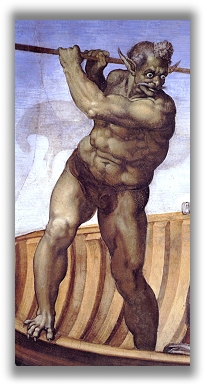
In Greek mythology, Charon was the boatman of the underworld who rowed the souls of the departed across a river to their eternal destination[2]. In most Greek texts the river is identified as the Acheron; in Latin works it is more commonly called the Styx. The dead who could not pay the fare were doomed to wander on the riverbank.
The origin of this story, and how widely it was actually believed, is uncertain. How did the dead pay for passage before coinage came into use?
As far as I can determine, Charon does not appear on any ancient coins. His boss Hades (Greek) or Pluto (Roman), the god of the underworld, appears on a wide range of second- and third-century provincial bronzes, usually in the act of abducting his bride, Persephone (Proserpina in Latin).
The Obol
An obol was originally a small silver coin, valued at one-sixth of a drachma. After the Greek-speaking cities of the eastern Mediterranean were absorbed into the Roman Empire, “obol” was often used to describe any low-value bronze coin. On the “Attic” weight standard of Athens, an obol weighed 0.72 grams. On the older weight standard of Aegina, an obol weighed 1.05 grams.
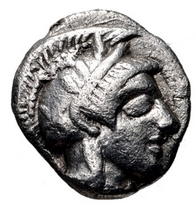
Obol coins are usually lighter than the theoretical weight. Ancient mints took a loss producing small change in precious metal, and often compensated by adjusting the weight downward.
The Greek word “obol” originally meant “roasting spit”, because bundles of iron roasting spits served as a primitive form of money before coinage. Such skewers are occasionally found in ancient graves and tombs, perhaps in expectation of feasting in the afterlife. Burial customs are highly conservative, so the small coin might have served as a convenient symbolic substitute for the iron skewer.
A recent survey of the literature on ancient coins found in excavations of ancient graves in Western Europe (Doyen, iii) notes that:
The deposit of a coin in the grave, sometimes described as the “Charon’s fee”, is a rite that is mentioned for the first time in literary sources from the second half of the 5th c. BC (Aristophanes, Frogs, v. 142). Charon did not appear on the mythological scene until rather late, and he never attained an official place in Greek mythology.
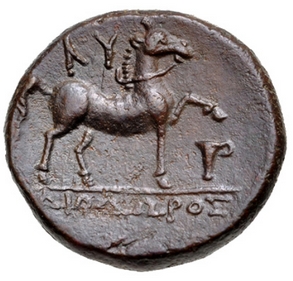
In archaeological excavations of pre-Christian Roman cemeteries, coins are typically found in 5 to 15% of burials (Campo, 75). In a survey of coin types found in first- to third-century Roman graves in Pannonia (modern Austria and Hungary) Gazdac (6) noted a high proportion of reverses like SALUS (“well-being”) and FELICITAS (“happiness”) that seem to express a benevolent wish for the deceased. He suggests that such types may have been deliberately selected by relatives.
The Elusive Danake
Small coin-like objects made of gold foil impressed with various designs occasionally appear in excavation reports or on the antiquities market. The terms danake (an Old Persian synonym for obol) or lamella (Latin for “piece of foil”) are typically used to describe such artifacts.
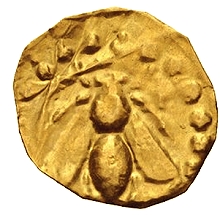
Numismatists describe these as “uniface” because the design appears on only one side. They usually weigh between half of a gram and a quarter of a gram and measure 6 to 12 mm in diameter. Again, burial customs are very conservative, and in the absence of any inscription, provenance or context such pieces can only be dated in the most general terms (“fifth to first century BCE”, for example). One type shows a “radiate” head, probably the sun god Helios or Apollo. Another type depicts a honeybee, perhaps expressing a wish for a sweet afterlife.
The most recent study of these artifacts is an article (in German) by the eminent German numismatist Wolfgang Fischer-Bossert (2009) who notes that:
…scholars hesitate to regard the mythology as the reason for the custom of Charon’s obol. The ferryman’s fee is often called a secondary, witty invention that conceals the intrinsic meaning of the custom. Two explanations have been favoured: a) the paying off of the dead that prevents his/her return, b) the equipment of the dead that enables him/her to maintain his/her status in the underworld. (117)
Ethics, Numismatics and the Dead
I think most people would agree that the remains of the dead, regardless of their culture or religious beliefs, should be undisturbed. Even when a compelling scientific or social purpose requires that human remains be disinterred and studied, they should receive the same respect that we would wish for the remains of our own loved ones. Although it is possible that these artifacts may have been separated from their funerary context through the action of plant roots, burrowing animals, groundwater, or construction, the most probable explanation for their appearance on the antiquities market is grave-robbing. Collectors might wish to consider the ethical implications of purchasing such objects.
Those who seek to ban the private ownership and trade in antiquities would love to depict all ancient coin collectors as complicit with tomb robbers and looters of archaeological sites. The reality is far more complex[3]. Most ancient coins are found in hoards–ceramic pots deliberately buried at a distance from buildings and inhabited areas. Coins in graves were typically of low value when buried, and generally being common types in base metal, are of little value on the antiquities market today.
We show respect for the remains of the deceased, not because they care, or because it benefits them in any way, but because this is simply one of the things that make us human.
* * *
Notes
[1] “The placement of coins on the eyes for burial is not securely attested in antiquity”
(https://en.wikipedia.org/wiki/Charon%27s_obol#Coins_on_the_eyes.3F). The purpose of this custom may be to keep the eyes of the deceased closed, since open eyes might be distressing to the living.
[2] The largest of the five known satellites of the dwarf planet Pluto was named Charon in 1986. The others are Styx (discovered 2012), Kerberos (2011), Nix and Hydra (both 2005).
[3] For a thoughtful and authoritative discussion of these issues, an excellent source is Peter Tompa’s blog: http://culturalpropertyobserver.blogspot.com/.
References
Campo, Marta. “Entorn el Mite de Caront: La Moneda a les Necropolis del Litoral Oriental de la Peninsula Iberica (segles IV aC II dC)” (in Catalan, “About the Myth of Charon: coinage in cemeteries of the eastern coast of the Iberian peninsula, 4th century BCE to 2nd century CE.) in Mites, ofrenes funeraries i monedes, National Art Museum of Catalunya, Barcelona (2011)
Doyen, Jean-Marc. “The Charon’s Obol: Some Methodological Reflexions”, Journal of Archaeological Numismatics 2 (2012)
Fischer-Bossert, Wolfgang. “Goldene Charonsgroschen” (in German), Kermatia philias. Athens Numismatic Museum. (2009)
Găzdac, Cristian, “Did Charon Read His Obol? The Message of Coin Offering in Roman Graves From Pannonia”, Dacia 58 (2014)
Stevens, Susan T. “Charon’s Obol and Other Coins in Ancient Funerary Practice”, Phoenix 45. (1991)
Sullivan, Francis A. “Charon: The Ferryman of the Dead”, The Classical Journal 46. (1950)
Travaini, Lucia. “Saints and Sinners: Coins in Medieval Italian Graves”, Numismatic Chronicle 164 (2004)
Weber, F. Parkes. Aspects of Death: and their Effects on the Living as Illustrated by Minor Works of Art, Especially Medals, Engraved Gems, Jewels, &c. London. (1910)
Wolff, Samuel R. “Mortuary Practices in the Persian Period of the Levant”, Near Eastern Archaeology 65. (2002)






